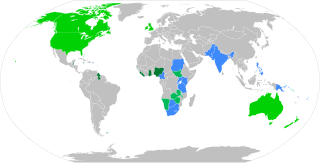
Speakers of English are also known as Anglophones, and the countries where English is natively spoken by the majority of the population are termed the Anglosphere. Over two billion people speak English as of the 2000s, making English the largest language by number of speakers, and the third largest language by number of native speakers.

Celosia is a small genus of edible and ornamental plants in the amaranth family, Amaranthaceae. The generic name is derived from the Ancient Greek word κήλεος, meaning "burning", and refers to the flame-like flower heads. Species are commonly known as woolflowers, or, if the flower heads are crested by fasciation, cockscombs. The plants are well known in East Africa's highlands and are used under their Swahili name, mfungu.

Nuytsia floribunda is a hemiparasitic tree found in Western Australia. The species is known locally as moodjar and, more recently, the Christmas tree or Western Australian Christmas tree. The display of intensely bright flowers during the austral summer coincides with the Christmas season.

Anredera is a genus of plants native to Latin America, the West Indies, Texas, and Florida. Some are naturalized in other regions. Most of them evergreen vines of dry scrubland and thickets. Members of the genus are commonly known as Madeira vines. At least one species, A. cordifolia bears edible roots or tubers and leaves similar to those of Basella alba.
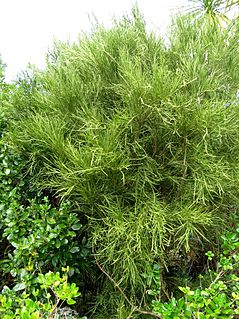
Carmichaelia is a genus of 24 plant species belonging to Fabaceae, the legume family. All but one species are native to New Zealand; the exception, Carmichaelia exsul, is native to Lord Howe Island and presumably dispersed there from New Zealand.

Bulbinella is a genus of plants in the family Asphodelaceae, subfamily Asphodeloideae, first described as a genus in 1843. Many species are endemic to Cape Province in western South Africa, confined to the winter rainfall area. Other species are endemic to New Zealand, where they are most common in the central Otago region which enjoys a similar climate to the Cape Region of South Africa.
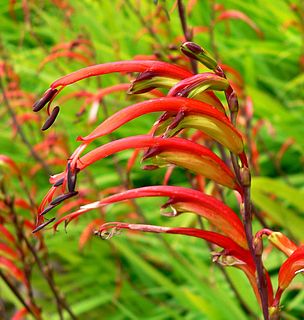
Chasmanthe is a genus of flowering plants in the family Iridaceae, first described in 1932. It is endemic to Cape Province in South Africa. It is widely grown as an ornamental and naturalized in various locations.
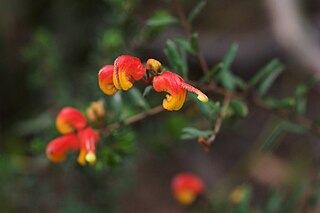
The Australian flowering shrub Grevillea alpina has several common names, including mountain grevillea, alpine grevillea, and cat's claws. It is not limited to alpine environments, and in fact is less common at high elevation than low. The species is variable in appearance, with five general forms described: small-flowered, Grampians, Northern Victorian, Goldfields, and Southern Hills forms. It is found in dry forests and woodlands across Victoria and into southern New South Wales. Some forms of the plant are low to the ground, and some become a spreading shrub. The flowers come in many colours, from white to green to shades of red and pink, or a pattern of several colours. The curled flowers are 1 to 3 centimetres in length. It is attractive to nectar-feeding insects and birds.
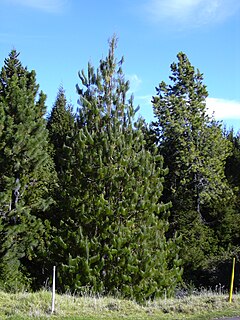
Pinus patula, commonly known as patula pine, spreading-leaved pine, or Mexican weeping pine, and in Spanish as pino patula or pino llorón, is a tree native to the highlands of Mexico. It grows from 24° to 18° North latitude and 1,800–2,700 m (5,900–8,900 ft) above sea level. The tree grows up to 30 m (98 ft) tall. It cannot withstand long periods of temperatures as low as −10 °C (14 °F), but resists occasional brief dips below 0 °C (32 °F). It is moderately drought-tolerant, and in this respect is superior to Pinus taeda. The average annual rainfall in its native habitat is from 750 to 2000 mm. This happens mostly in summer, but in a little area of the State of Veracruz on the Sierra Madre Oriental its habitat is rainy the year round.

Acacia floribunda is a perennial evergreen shrub or tree. It is a species of wattle native to New South Wales, Queensland and Victoria, but is cultivated extensively, and has naturalised in South Australia, Tasmania and Western Australia, and also in Indonesia, Mauritius and northern New Zealand. Common names for it include gossamer wattle, weeping acacia and white sallow wattle. It grows up to 6m in height, but there is a commercial form available which only grows to about 1m tall. Its cream-colored flowers occur in the early Spring.

Chasmanthe floribunda is a species of flowering plant in the iris family which is known by the common name African flag. This plant is endemic to Cape Province in South Africa, but it has been introduced to other areas of similar climate, and is considered to be naturalized in California, Algeria, Australia, Argentina, and St. Helena.

Senecio angulatus, also known as creeping groundsel and Cape ivy, is a succulent flowering plant in the daisy family that is native to South Africa. Cape ivy is a scrambling and a twining herb that can become an aggressive weed once established, making it an invasive species. It has been naturalised in the Mediterranean Basin, where it is grown as an ornamental plant for its satiny foliage and sweet-scented flowers.
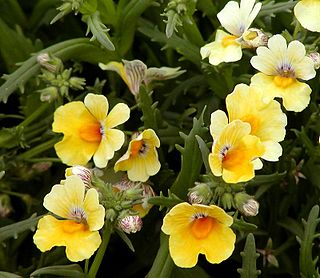
Nemesia is a genus of annuals, perennials and sub-shrubs which are native to sandy coasts or disturbed ground in South Africa. Numerous hybrids have been selected, and the annual cultivars are popular with gardeners as bedding plants. In temperate regions they are usually treated as half-hardy, grown from seed in heat, and planted out after all danger of frost has passed.

Angophora floribunda, commonly known as the rough-barked apple, is a common woodland and forest tree of the family Myrtaceae native to Eastern Australia. Reaching 30 m (100 ft) high, it is a large tree with fibrous bark and cream-white flowers that appear over the Austral summer. It grows on alluvial soils on floodplains and along watercourses. Much of the land it grew on has been cleared for agriculture.
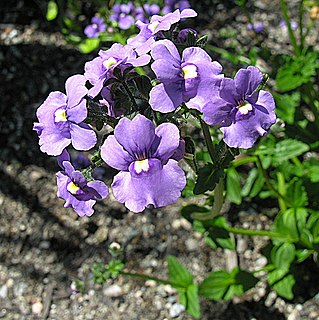
Nemesia caerulea is a blue- to purple- flowered herbaceous perennial member of the family Scrophulariaceae. The plant is native to the Cape Floristic Province of southwestern South Africa, where it grows at low elevations on fully exposed north-facing and northwest-facing slopes in association with other native grasses and forbs. Its chromosome number is 2n=18.
N. floribunda may refer to:
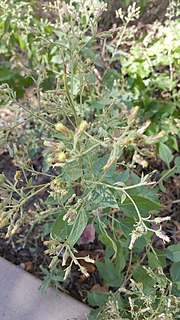
Brickellia floribunda, the Chihuahuan brickellbush, is a North American species of flowering plants in the daisy family. It is native to northern Mexico and the south-western United States.

Nemesia denticulata, the toothed aloha, is a species of flowering plant in the genus Nemesia of the figwort family Scrophulariaceae, native to South Africa. A mat‑forming perennial useful for borders, it has gained the Royal Horticultural Society's Award of Garden Merit.
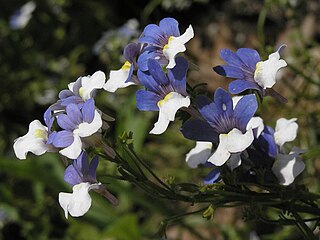
Nemesia strumosa, Cape jewels or pouch nemesia, is a species of flowering plant in the family Scrophulariaceae, native to the southwestern Cape Provinces of South Africa. Suited for garden applications such as beds, borders, rock gardens and containers, its cultivars come in a wide variety of flower colors, including bicolored. When grown as a cool‑weather annual it can be planted in USDA zones 2 through 10.


















